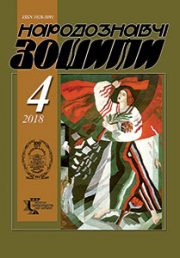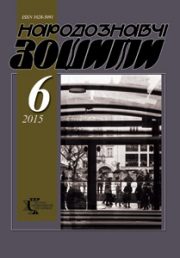The Ethnology Notebooks. 2023. № 4 (172), 978—985
UDK [398.3:393](477.86)
DOI https://doi.org/10.15407/nz2023.04.978
HOROSHKO-POHORETSKA Lesya
- ORCID ID: https://orcid.org/0000-0002-8741-2467
- Candidate of Historical Sciences (= Ph.D. in history)
- Senior Researcher at the Ethnology Institute
- of National Academy of Sciences of Ukraine,
- 15, Svobody Avenue, 79000, Lviv, Ukraine,
- Contacts: e-mail: horoshyna@gmail.com
Abstract. The fact that death is an integral part of every person’s life testifies to the relevance of this topic. Therefore, the purpose of the article is to consider the complex of ritual and worldview phenomena associated with the onset of death. The object of the study is the traditional worldview and customary and ritual culture of the inhabitants of Pokuttia, and the subject — beliefs, omens and instructions which were followed and which were taken into account at the time of death in Pokuttia. Among them are signs that could herald the approach of death (peculiar behavior of animals, observations of plant life, dreams, unusual sounds in the home, the appearance of ritual or everyday bread and a sick or dead person, the direction of smoke from a candle, garbage, etc. in calendar and funeral rites), measures to relieve agony (confession, communion, anointing with oil, promulgation of the last will and testament, praying for the sick, pouring him with holy or ordinary water, transferring him from bed to a bench, removing a feather pillow, covering him with consecrated objects, etc.).
The basis for the research are the materials of the author’s field research during 2013—2014 in the villages of Kolomyjs’kyj, Horodenkivs’kyj, Sniatyns’kyj, Tlumats’kyj and Tysmenyts’kyj districts of Ivano-Frankivs’k oblast’, and works of the end of nineteenth and the beginning of twenty-first centuries. The methodology of this work is based on general scientific methodological principles and the basic requirements that apply to the works of historic and ethnological direction.
It was found out that the ethnolocal version of the funeral customs of Pokuttia has specific Ukrainian features. At the same time it conserves the distinctive manifestation.
Keywords: omens, beliefs, death, agony, dying, sick, Pokuttia.
Received 26.06.2023
REFERENCES
- Kolberg, O. (1961). Pokucie. In Kolberg, О. (Ed.). All works (Vol. 29, p. 1). Wroclaw; Poznan: Polskie Wydawnictwo Muzyczne; Ludowa Spoldzielnia Wydawnicza [in Polish].
- Kolberg, O. (1963). Pokucie. In Kolberg, О. (Ed.) All works (Vol. 31, p. 3). Wroclaw; Poznan: Polskie Wydawnictwo Muzyczne; Ludowa Spoldzielnia Wydawnicza [in Polish].
- Mroczko, K.Fr. (1897). Sniatynszczyzna. (A contribution to national ethnography). Scientific and literary guide, VI, VII (Vol. XXV, pp. 481—498; pp. 577—595) [in Polish].
- Voloshynskyj, I. (1919). Funeral customs and wailing in the Horodenka region. Materials for Ukrainian ethnology (Vol. ХІХ—ХХ, pp. 194—213) [in Ukrainian].
- Kysilevska, O. (1912). Funeral customs and rites in the village of Tovmachyk, Kolomyja district. In Hnatiuk, V. Funeral customs and rites. Ethnographic collection (Vol. XXXI—XXXII, pp. 299—302) [in Ukrainian].
- Mykhajlovskyj, O. (1912). Funeral customs and rites in the village of Trostianets, Sniatyn district. In Hnatiuk, V. Funeral customs and rites. Ethnographic collection (Vol. XXXI—XXXII, pp. 302—315) [in Ukrainian].
- Onyshchuk, A. (1912). Funeral customs and rites in the village of Karliv, Sniatyn district. In Hnatiuk, V. Funeral customs and rites. Ethnographic collection (Vol. XXXI—XXXII, pp. 315—338) [in Ukrainian].
- Skrypnyk, H. (Ed.). Ethnographic image of modern Ukraine. Corps of expeditionary folklore and ethnographic materials. Funeral and memorial customs and rites (Vol. 5). Kyiv: NAN Ukrainy; IMFE named after M.T. Rylskyj [in Ukrainian].
- Serebriakova, O.H. (2013). Pokuttia (field materials collected in Kolomyjs`kyj and Sniatyns’kyj districts of Ivano-Frankivs`k region). Archive of the IN NANU (Archive of the Institute of Ethnology of the National Academy of Sciences of Ukraine). F. 1. Op. 2. Od. save 704. Arc. 1—51 [in Ukrainian].
- Serebriakova, O.H. (2014). Pokuttia (field materials collected in Tlumats’kyj, Tysmenyts`kyj and Horodenkivs`kyj districts of Ivano-Frankivs`k region). Archive of the IN NANU. F. 1. Op. 2. Od. save 771. Arc. 1—175 [in Ukrainian].
- Serebriakova, O.H. (2016—2017). Pokuttia (field materials collected in Horodenkivs’kyj district of Ivano-Frankivs`k region). Archive of the IN NANU. F. 1. Op. 2. Od. save 782. Arc. 1—253 [in Ukrainian].
- Horoshko, L.M. (2013). Field materials from Pokuttia (Kolomyjs’kyj, Horodenkivs’kyj, Tlumats’kyj, Snyatins’kyj districts, Ivano-Frankivs’k oblast’). Archive of the IN NANU. F. 1. Op. 2. Od. save 698. Arc. 1—116 [in Ukrainian].
- Horoshko-Pohoretska, L.M. (2014). Field materials from Pokuttia (Tlumats’kyj, Tysmenyts’kyj, Horodenkivs’kyj districts, Ivano-Frankivs’k oblast’). Archive of the IN NANU. F. 1. Op. 2. Od. save 736. Arc. 1—97 [in Ukrainian].
- Pankiv, M.I. (1988). Family and family life on Pokutye (1850—1980). (Candidate dissertation). Archive of the IN NANU. F. 1. Op. 2. Od. save 355 b. Arc. 1—188 [in Russian].
- Pankiv, M. (2002). My mother, my little cuckoo… («Mamko moja, zozulen’ko moja…») (Funeral and memorial customs and rites in Pokuttia). Berehynia, 1, 37—54 [in Ukrainian].
- Vozniak, V. (2003). My village — Ukraine’s blossom. Ivano-Frankivsk: Nova Zoria [in Ukrainian].
- Hetman, I.V. (2002). History of the village of two brothers (Bratkivtsi). Ivano-Frankivsk: Library of the newspaper «Vpered» [in Ukrainian].
- Petruk, M. & Petruk, P. (2000). The history of Tovmachyk: Historical and ethnographic essay. Kolomyja: Vil’nyj holos [in Ukrainian].
- Pankiv, M. (2000). Wedding in the village of Verbivtsi in Horodenkivshchyna. Ivano-Frankivsk: Lileja-NV [in Ukrainian].
- Serebriakova, O. (2022). Commemorative motifs of the Christmas and Epiphany cycle of Ukrainian holidays (on the example of mantic actions with spoons). The Ethnology notebooks, 5 (167), 1121—1132 [in Ukrainian].
- Borysenko, V. (1994). Funeral customs and rites. In Podillia: Historical and ethnographic research (Pp. 228—232). Kyiv: Dolia [in Ukrainian].
- Horoshko, L. (2005). The manistic aspect of the use of water for cleansing purposes in the funeral rites of Ukrainians (Hutsul ethnolocal variant). Grazhda, 11, 45—47 [in Ukrainian].
- Huzij, R. (2007). From folk thanatology: Carpathian studies. Lviv: IN NANU [in Ukrainian].
- Huzij, R. (1998). Folk remedies for easing the dying process (Carpathian tradition). The Ethnology notebooks, 3, 330—334 [in Ukrainian].
- Huzij, R. (2006). Funeral customs and rites. In Ethnogenesis and ethnic history of the population of the Ukrainian Carpathians: in 4 vols. (Vol. 2: Ethnology and art history, pp. 569—589). Lviv [in Ukrainian].
- Huzij, R. (2000). Ritual mourning of the dead in the funeral customs of the Carpathian Ukrainians. The Ethnology notebooks, 5, 809—815 [in Ukrainian].
- Huzij, R.B. (2002). Funeral customs and rites of Carpathian Ukrainians (XIX—XX centuries). (Candidate dissertation). Ivan Krypjakevych Institute of Ukrainian Studies of the National Academy of Sciences of Ukraine; Institute of Ethnology of the National Academy of Sciences of Ukraine [in Ukrainian].
- Huzij, R., Warhol, J. & Warhol, N. (2002). Funeral rites. In Lemkivshchyna: Historical and ethnographic research (Vol. 2: Spiritual culture, pp. 94—109). Lviv: IN NANU [in Ukrainian].
- Koval-Fuchylo, I. (2015). Hutsul funeral rite: dynamics and semantics. In Lemkowie, Bojkowie, Rusini: historia, wspolczesnosc, kultura materialna i duchowa (Vol. V, pp. 571—586). Slupsk; Zielona Gora; Svidnik: Oficyna wydawnicza Uniwersytetu Zielonogуrskiego [in Ukrainian].
- Kryvenko, A. (2020). Family customs and ceremonies. In Everyday life of Galicians in the 19th and early 20th centuries. Kharkiv: Folio [in Ukrainian].
- Kutelmakh, K. (1997). Commemorative motifs in the calendar rituals of the inhabitans of Polissia. In Polissia of Ukraine: Materials of historical and ethnographic research. Kyiv Polissia. 1994 (Issue 1, pp. 172—203). Lviv: IN NANU [in Ukrainian].
- Serebriakova, O. (2008). Piromantic in calendar rituals (customs and beliefs of the Ukrainians of the Carpathians). In History of religions in Ukraine: scientific yearbook (Book I, pp. 128—134). Lviv: Lohos [in Ukrainian].
- Sushko, V.A. (2012). Life is endless: funeral rites of Ukrainians of Slobozhanshchyna in the 19th—21st centuries. Kharkiv: SPDFO Brovin O.V. [in Ukrainian].
- Siavavko, E.I. (1987). Family rites. In Hutsul’shchyna: Historical and ethnographic research (Pp. 314—316). Kyiv: Naukova dumka [in Ukrainian].
- Taran, O. (2013). Archaic elements of the pre-funeral cycle of Ukrainians (based on field research in the Northern Mykolaiv region). In Local and regional specifics of traditional culture: collection of scientific papers: materials of the international scientific conference «Odesa Ethnographic Readings» (Pp. 505—512). Odesa: KP OMD [in Ukrainian].
- Tkachenko, H. (2009). Funeral rites in Perejaslav region at the end of the 19th — at the beginning of the 20th century. In Pereyaslavica: scientific notes of the National Historical and Ethnographic Reserve «Pereyaslav»: collection of scientific papers (Issue 3 (5), pp. 263—266). Perejaslav-Khmelnytskyj [in Ukrainian].
- Uljanovska, S. (1992). Magical elements of the Polissia funeral ritual (based on the materials of Volyn and Central Polissia). Folk creativity and ethnography, 2, 69—74 [in Ukrainian].
- Cherleniak, I.V. (2016). Funeral and memorial rites of Ukrainians of Transcarpathia at the end of the 19th and the first half of the 20th centuries. Notes of the Faculty of History (Issue 27, pp. 197—221). Odesa: Odesa National University named after I.I. Mechnikov [in Ukrainian].






